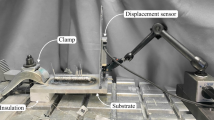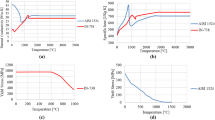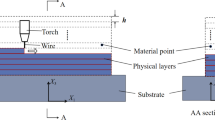Abstract
In this study, an experiment-based distortion prediction model for wire-based additive manufactured (AM) parts is proposed. Based on the assumptions for predicting the longitudinal bending distortion in inherent strain theory, the experiment-based distortion prediction model for wire-based AM parts was defined. Subsequently, an experimental study was designed based on the defined assumptions, which were validated through experiments. Consequently, based on these assumptions, a shell element-based elastic finite element (FE) approach was applied to the wire-based AM parts. The proposed experiment-based distortion prediction model was in good agreement with the validation case studies. In addition, the feasibility of a fast simulation approach for wire-based AM parts using the elastic FE approach was demonstrated. Based on these results, it was concluded that the proposed model can be applied for fast deformation predictions of AM structures.
Similar content being viewed by others
References
D. Ding, Z. Pan, D. Cuiuri and H. Li, Wire-feed additive manufacturing of metal components: technologies, developments and future interests, The International Journal of Advanced Manufacturing Technology, 81(1) (2015) 465–481.
A. Ahmed, A. Majeed, Z. Atta and G. Jia, Dimensional quality and distortion analysis of thin-walled alloy parts of AlSi10Mg manufactured by selective laser melting, Journal of Manufacturing and Materials Processing, 3(2) (2019) 51.
M. Chiumenti, X. Lin, M. Cervera, W. Lei, Y. Zheng and W. Huang, Numerical simulation and experimental calibration of additive manufacturing by blown powder technology, part I: thermal analysis, Rapid Prototyping Journal, 23(2) (2017) 448–463.
J. Lee and H. Chung, Experimental investigation of deposition pattern on the temperature and distortion of direct energy deposition-based additive manufactured part, Applied Sciences, 10(21) (2020) 7653.
T. Shin, S. J. Park, K. S. Kang, J. S. Kim, Y. Kim, Y. Lim and D. Lim, A laser-aided direct metal tooling technology for artificial joint surface coating, International Journal of Precision Engineering and Manufacturing, 18(2) (2017) 233–238.
S. A. M. Tofail, E. P. Koumoulos, A. Bandyopadhyay, S. Bose, L. O’Donoghue and C. Charitidis, Additive manufacturing: scientific and technological challenges, market uptake and opportunities, Materials Today, 21(1) (2018) 22–37.
M. O. Shaikh, C. C. Chen, H. C. Chiang, J. R. Chen, Y. C. Chou, T. Y. Kuo, K. Ameyama and C. H. Chuang, Additive manufacturing using fine wire-based laser metal deposition, Rapid Prototyping Journal, 26(3) (2020) 473–483.
J. L. Z. Li, M. R. Alkahari, N. A. B. Rosli, R. Hasan, M. N. Sudin and F. R. Ramli, Review of wire arc additive manufacturing for 3D metal printing, International Journal of Automation Technology, 13(3) (2019) 346–353.
S. Negi, A. A. Nambolan, S. Kapil, P. S. Joshi, R. Manivannan, K. P. Karunakaran and P. Bhargava, Review on electron beam based additive manufacturing, Rapid Prototyping Journal, 26(3) (2020) 485–498.
D. Liu, B. Lee, A. Babkin and Y. L. Chang, Research progress of arc additive manufacture technology, Materials, 14(6) (2021) 1415.
A. Ikram and H. Chung, Computational analysis of metal transfer mode, dynamics, and heat transfer under different pulsating frequencies in pulsed wire-arc additive manufacturing, Journal of Computational Design and Engineering, 9(3) (2022) 1045–1063.
E. Karayel and Y. Bozkurt, Additive manufacturing method and different welding applications, Journal of Materials Research and Technology, 9(5) (2020) 11424–11438.
J. L. Davila, P. I. Neto, P. Y. Noritomi, R. T. Coelho and J. V. L. da Silva, Hybrid manufacturing: a review of the synergy between directed energy deposition and subtractive processes, The International Journal of Advanced Manufacturing Technology, 110(11–12) (2020) 3377–3390.
D. Jafari, T. H. J. Vaneker and I. Gibson, Wire and arc additive manufacturing: opportunities and challenges to control the quality and accuracy of manufactured parts, Materials and Design, 202 (2021) 109471.
Z. Pan, D. Ding, B. Wu, D. Cuiuri, H. Li and J. Norrish, Arc welding processes for additive manufacturing: a review, Transactions on Intelligent Welding Manufacturing (2018) 3–24.
J. Fuchs, C. Schneider and N. Enzinger, Wire-based additive manufacturing using an electron beam as heat source, Welding in the World, 62(2) (2018) 267–275.
K. Masubuchi, Chapter 3 — fundamental information on residual stresses, Analysis of Welded Structures, Pergamon (1980).
K. Masubuchi, Chapter 7 — distortion in weldments, Analysis of Welded Structures, Pergamon (1980).
H.-S. Shin and S.-H. Boo, Welding simulation using a reduced order model for efficient residual stress evaluation, Journal of Computational Design and Engineering, 9(4) (2022) 1196–1213.
F. Li, S. Chen, J. Shi and Y. Zhao, In-process control of distortion in wire and arc additive manufacturing based on a flexible multi-point support fixture, Science and Technology of Welding and Joining, 24(1) (2019) 36–42.
E. R. Denlinger and P. Michaleris, Mitigation of distortion in large additive manufacturing parts, Proceedings of the Institution of Mechanical Engineers, Part B: Journal of Engineering Manufacture, 231(6) (2015) 983–993.
J. R. Hönnige, P. A. Colegrove, S. Ganguly, E. Eimer, S. Kabra and S. Williams, Control of residual stress and distortion in aluminium wire + arc additive manufacture with rolling, Additive Manufacturing, 22 (2018) 775–783.
F. Montevecchi, G. Venturini, A. Scippa and G. Campatelli, Finite element modelling of wire-arc-additive-manufacturing process, 5th Cirp Global Web Conference — Research and Innovation for Future Production (CIRPE 2016) (2016) 109–114.
L. E. Lindgren, Numerical modelling of welding, Computer Methods in Applied Mechanics and Engineering, 195(48) (2006) 6710–6736.
J. Ding, Thermo-mechanical analysis of wire and arc additive manufacturing process, Ph.D. Thesis, Cranfield University, England (2012).
M. Kim, M. Kang and H. Chung, Simplified welding distortion analysis for fillet welding using composite shell elements, International Journal of Naval Architecture and Ocean Engineering, 7(3) (2015) 452–465.
J. Ding, P. Colegrove, J. Mehnen, S. Ganguly, P. M. Sequeira Almeida, F. Wang and S. Williams, Thermo-mechanical analysis of wire and arc additive layer manufacturing process on large multi-layer parts, Computational Materials Science, 50(12) (2011) 3315–3322.
H. Huang, N. Ma, J. Chen, Z. Feng and H. Murakawa, Toward large-scale simulation of residual stress and distortion in wire and arc additive manufacturing, Additive Manufacturing, 34 (2020) 101248.
J. Wang, S. Rashed and H. Murakawa, Mechanism investigation of welding induced buckling using inherent deformation method, Thin-Walled Structures, 80 (2014) 103–119.
R. Craig, Mechanics of Materials, Third Ed., John Wiley and Sons, New Jersey (2011).
S.-M. Cho, D.-S. Oh, H.-S. Ham, H.-J. Ha, H.-S. Shin, J.-H. Jun, J.-G. Byun, J.-H. Park and H.-Y. Kwon, Filler Metal for TIG Welding, Patent No. US201614912899A, U.S. Patent and Trademark Office (2016).
J. H. Jun, J. H. Park, M. Cheepu and S. M. Cho, Observation and analysis of metal transfer phenomena for high-current super-TIG welding process, Science and Technology of Welding and Joining, 25(2) (2020) 106–111.
M. Cheepu, C. I. Lee and S. M. Cho, Microstructural characteristics of wire arc additive manufacturing with Inconel 625 by super-TIG welding, Transactions of the Indian Institute of Metals, 73(6) (2020) 1475–1479.
K. Sirin, S. Sirin and E. Kaluc, Influence of the interpass temperature on t8/5 and the mechanical properties of submerged arc welded pipe, Journal of Materials Processing Technology, 238 (2016) 152–159.
M. Yi, The effect of geometry non-linearity in welding deformation, Master’s Thesis, Pusan National University, Republic of Korea (2007).
J. Lee, Development of efficient welding distortion analysis method for large welded structure, Ph.D. Thesis, Korea Advanced Institute of Science and Technology, Republic of Korea (2019).
Y. Luo, M. Ishiyama and H. Murakawa, Welding deformation of plates with longitudinal curvature, Transaction of JWRI, 28(2) (1999) 57–65.
Acknowledgments
This work was supported by the National Research Foundation of Korea (NRF) grant funded by the Korea government (MSIT; number 2021R1G1A1006628). Also this research was supported by Chonnam National University (Smart Plant Reliability Center) grant funded by the Ministry of Education (2020R1A6C101B197).
Author information
Authors and Affiliations
Corresponding author
Additional information
Jaemin Lee is an Assistant Professor of the Department of Naval Architecture & Ocean Engineering, Chonnam National University, Yeosu, Korea. He received his Ph.D. in Mechanical Engineering from KAIST. His research interests include advanced welding and joining process and its quality control and its applications to metal additive manufacturing.
Muralimohan Cheepu is a Research Manager of the Super-TIG welding Co., Ltd., Busan, Korea. He received his Ph.D. in Mechatronics and Mechanical Engineering from Kyungsung University. His research interests include additive manufacturing/3D printing, welding and joining, welding metallurgy, tribology, simulation and machine learning.
Hyun Chung is a Professor of the Department of Naval Architecture & Ocean Engineering, and the Department of Autonomous Vehicle System. Engineering, Chungnam National University, Daejeon, Korea. He received his Ph.D. in Naval Architecture & Marine Engineering from the University of Michigan. His research interests include stochastic variations in thermo-elastoplastic analysis, multi-physical simulation of gas metal arc welding processes and its applications to metal additive manufacturing, and artificial intelligence-based decision-making tools for ship and offshore applications.
Rights and permissions
About this article
Cite this article
Lee, J.M., Cheepu, M. & Chung, H. Experiment-based distortion prediction model for wire-based additive manufactured parts. J Mech Sci Technol 36, 6227–6237 (2022). https://doi.org/10.1007/s12206-022-1136-0
Received:
Revised:
Accepted:
Published:
Issue Date:
DOI: https://doi.org/10.1007/s12206-022-1136-0




